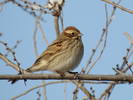search
classification
|
basic information
|
video
|
reports |
Northern Reed Bunting
Emberiza schoeniclus (Linnaeus, 1758)

|
 male
|
|
|
2015-03-01
Ozernoe village, Chuy region |
© Sergey Toropov
|
|
Biology
Common breeding migrant (northern thin-billed group of subspecies wintering in south Kazakhstan) or resident (southern thick-billed group of subspecies). Inhabits bush thickets on marshes (northern group) or reed-beds and riparian thickets (southern group), on migration thin-billed birds occurs on meadows with bushes, in shelterbelts, thickets of tall weeds and in reed-beds; the thick-billed birds in summer occurs in the willow bushes where they breed rarely. In southern Kazakhstan in spring the thin-billed birds begin to migrate from March until mid-April, latest birds observed in early May. In central and northern regions of Kazakhstan Reed Buntings appear in early April, most of birds migrate in second half of April, the latest ones recorded in mid-May. Breeds in separate pairs, pretty close from each other. Nest is located on the ground or on the marsh tussock, and accurate camouflaged by the grass; or in reeds low above the ground or water level. Nest is built from the dry grass and leaves and is lined by the rootlets and hair (thin-billed group); or from the reed leaves and is lined by the reed brooms and thin stems (thick-billed group). Clutch of 4-6 eggs is laid in end of April – mid-June. For 13 days mainly female incubates clutch with some male’s participation. Re-nesting after the loss of first clutch is common. Can rear two broods per year too. Autumn migration begins in September, from northern regions Reed Buntings disappear in end of October. Thick-billed subspecies migrate not so far, as thin-billed ones.
References
Gavrilov E. I., Gavrilov A. E. "The Birds of Kazakhstan". Almaty, 2005. Э.И.Гаврилов. "Фауна и распространение птиц Казахстана". Алматы, 1999. В.К.Рябицев. "Птицы Урала, Приуралья и Западной Сибири". Екатеринбург. Издательство Уральского университета, 2000.














